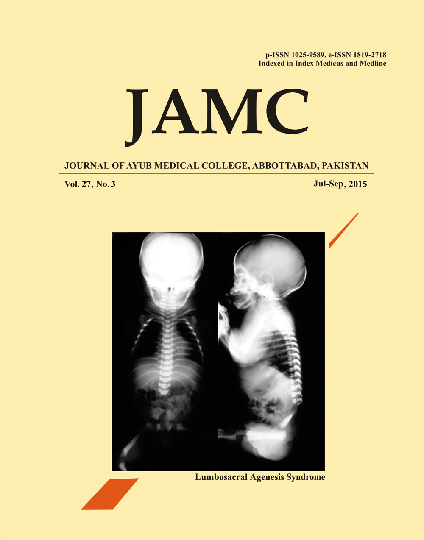PREVALENCE AND ASSOCIATED RISK FACTORS OF UNDER NUTRITION AMONG CHILDREN AGED 6 TO 59 MONTHS IN INTERNALLY DISPLACED PERSONS OF JALOZAI CAMP, DISTRICT NOWSHERA, KHYBER PAKHTUNKHWA
Abstract
Background: The magnitude of under nutrition among children below five years of age is high in Pakistan. Undernutrition and infections are the two most important factors that affect the growth of children. This study explains the extent of undernutrition and prevalence of wasting and stunting among preschool children. Methods: This cross sectional study with a sample size of 446 covered the age group 6–59 months in Jalozai Camp, District Nowshera. Height for age, weight for age and weight for height were measured as per WHO guidelines. Systematic random sampling technique was used for sample selection. Data was collected using a questionnaire. Results: According to height for age Z-score, out of 446 children studied, 8.5% were stunted and 4.0% were severely stunted. According to weight for age Z score, 11.4% were underweight and 3.6% were severely underweight. According to weight for height Z-score, 4.0% were wasted and 2.7% were severely wasted. Conclusion: The undernutrition in children is comparable to the national figures. Although our study found that absence of formal education, big family size, late and early weaning, absence of exclusive breast feeding and poverty were the factors associated with undernutrition in children, they could cause increase in under nutrition in future if not improved.References
Pelletier DL, Olson CM, Frongillo Jr E. Food insecurity, hunger, and under nutrition. In: Bowman BA, Russell RM, editors. Present knowledge in nutrition. 8th ed. Washington DC: ILSI press; 2006. pp.701–13.
Muller O, Krawinkel M. Malnutrition and health in developing countries. CMAJ 2005;173(3):279–86.
Shears P, Berry AM, Murphy R, Nabil MA. Epidemiological assessment of the health and nutrition of Ethiopina refugees in emergency camps in Sudan 1985. Br Med J (Clin Res Ed) 2007;295(6593):314–8.
Collins S, Dent N, Binns P, Bahwere P, Sadler K, Hallam A. Management of severe acute malnutrition in children. Lancet 2006;368(9551):1992–2000.
Shannon K, Mahmud Z, Asfia A, Ali M. The social and environmental factors underlying maternal under nutrition in rural Bangladesh: Implications for reproductive health and nutritional programs. Health Care Women Int 2008;29(8):826–40.
National Nutrition Survey Aga Khan University, Pakistan Medical Research Council and Nutrition Wing, Cabinet Division, Government of Pakistan 2011.
WFP/UNICEF, Author. Health and nutritional assessment in internally displaced people living in camps, Gulu district, 2005.
ACF-USA, author. Field Report of nutritional assessment in IDPs, Gulu district northern Uganda, 2005.
WFP/UNICEF. WFP/UNICEF, Author. Health and nutritional assessment of internally displaced persons living in camps in Kitgum district, 2005b.
Ali SS, Karim N, Billoo AG, Haider SS. Association of literacy of mothers with under nutrition among children under three years of age in rural area of district Malir, Karachi. J Pak Med Assoc 2005;55(12):550–3.
David S, Lobo M. Childhood Diarrhea and Under nutrition in Pakistan, Part II: Treatment and Management. J Pediatr Nurs 1995;10(3):204–9.
Toole MJ, Waldman RJ. The public health aspects of complex emergencies and refugee situations. Annu Rev Public health 2007;18:283–312.
Published
Issue
Section
License
Journal of Ayub Medical College, Abbottabad is an OPEN ACCESS JOURNAL which means that all content is FREELY available without charge to all users whether registered with the journal or not. The work published by J Ayub Med Coll Abbottabad is licensed and distributed under the creative commons License CC BY ND Attribution-NoDerivs. Material printed in this journal is OPEN to access, and are FREE for use in academic and research work with proper citation. J Ayub Med Coll Abbottabad accepts only original material for publication with the understanding that except for abstracts, no part of the data has been published or will be submitted for publication elsewhere before appearing in J Ayub Med Coll Abbottabad. The Editorial Board of J Ayub Med Coll Abbottabad makes every effort to ensure the accuracy and authenticity of material printed in J Ayub Med Coll Abbottabad. However, conclusions and statements expressed are views of the authors and do not reflect the opinion/policy of J Ayub Med Coll Abbottabad or the Editorial Board.
USERS are allowed to read, download, copy, distribute, print, search, or link to the full texts of the articles, or use them for any other lawful purpose, without asking prior permission from the publisher or the author. This is in accordance with the BOAI definition of open access.
AUTHORS retain the rights of free downloading/unlimited e-print of full text and sharing/disseminating the article without any restriction, by any means including twitter, scholarly collaboration networks such as ResearchGate, Academia.eu, and social media sites such as Twitter, LinkedIn, Google Scholar and any other professional or academic networking site.









